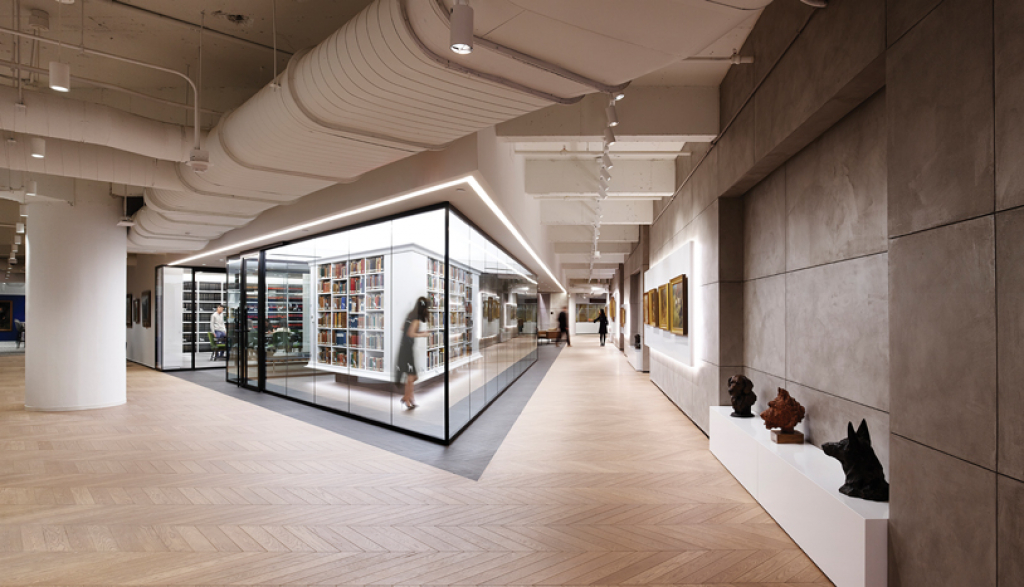A Tech Revolution: Reimagining the Museum of the Dog

Technology has transformed the way the world consumes media—and art is no exception. Today, museums around the globe have embraced technology as a means of enhancing the visitor’s experience. So, when the American Kennel ClubGo to https://stobuildinggroup.com/projects/american-kennel-club/ (AKC) decided it was time to return the Museum of the Dog (MOD) to its New York City roots, they saw the move as the perfect opportunity to bring the museum into the 21st century.
After 30 years in St. Louis, Missouri, the new-and-improved Museum of the Dog sits on the ground and third floors of 101 Park Avenue, right in the heart of bustling Midtown Manhattan. As guests enter the new space, they’re welcomed by 18ft-high ceilings, terrazzo floors, a vast mezzanine, retail store, and 180 canine-related works of art—including a 2,000-year-old paw print. The building’s glass façade allows light to fill the space, and a central staircase connects one level to the next.
A DIGITAL TWIST
But for AKC, relocating the Museum of the Dog was as much about elevating their visitors’ experience as it was creating a beautiful physical space. The goal was to create a unique, engaging experience while providing as much education as possible. Together with Gensler, the AKC designed their own interactive, technological elements to do just that.
Before walking in the door, guests are greeted with digital silhouettes of dogs, which appear to be parading down Park Avenue alongside the crowds. This feature is so lifelike, Structure Tone New York project manager, Anthony Crawford, recalls observing pedestrians’ reactions one night during the commissioning phase. “Most New Yorkers walk around staring at their phones,” he says. “But there was one woman in particular who asked us how we got the dogs up there behind the screen!”
Once inside, visitors can get their photos taken at one of two kiosks to find out which dog breed they resemble most. AKC even developed their own digital puppies: Arty and Molly. Visitors can train Molly to obey voice commands at the “Train a Dog on the Job” station, while Arty keeps the museum’s younger patrons engaged through a scavenger hunt app similar to Pokémon GO.
TIGHT QUARTERS
While these elements make the space one-of-a-kind, fitting the technology, artwork, and design elements within the museum’s 15,000sf proved to be one of the construction team’s biggest challenges.
Logistics. One of the main obstacles was installing the three-story staircase and a three-stop, hydraulic elevator. The site’s size and layout made it extremely difficult to maneuver the massive equipment and materials necessary to install both elements. To get the job done, the entire project team—from the design and construction crews to specialized subcontractors and MEP trades—came together several times to discuss strategy.
They decided to shift the position of the elevator and staircase so they’d both fit. The design team also eliminated a few risers from the stairs and added multilevel landings to adjust for the limited space. Once installed, the staircase became one of the most eye-catching aspects of the ground floor with its terrazzo treads and beautiful glass railings. “The staircase wraps around a large vitrine,” Crawford says. “As you walk up the steps, you get to see all the artifacts and exhibits up-close.”
Artwork. Another hurdle was fitting all 180 works of art—many of which are three dimensional—into the tight area. With one wall already occupied by the building’s glass façade, display space was extremely limited. To create additional space for the artwork, the team installed seven steel-framed partitions that resemble large-scale easels and rotate a full 360 degrees. These versatile frames not only provide prime display space, but they allow the museum to create completely distinct displays for events or special exhibits.
UNITED COLLECTION
One of the main reasons AKC decided to bring the Museum of the Dog back to New York City was the fact that their headquarters was still in Manhattan—along with a good portion of the organization’s growing art collection. With their art split between two locations and nearly 1,000 miles apart, AKC knew they were missing out on showing some of the key pieces in their 2,500-piece collection. So, the organization decided to relocate their office space to 101 Park Avenue as well and, again, saw the move as an opportunity to modernize their headquarters.
The revamped HQ now features breakout areas and executive suites, a boardroom equipped with cutting-edge communication technology, and three unique libraries to house AKC’s book collection. The office also displays plenty of canine-themed artwork, starting with the collection of canes in the main lobby area, each of which has a uniquely crafted head and was donated by AKC supporters.
With a more dynamic space and the freedom to exhibit new pieces, the museum’s relocation has been highly successful. In Missouri, the Museum of the Dog averaged 300–400 visitors per week. Since officially opening this year in New York, it’s averaged 1,000 visitors per week and up to 800 visitors on weekends.
Project Details
Size: 40,000sq
Client: American Kennel Club
Ownere’s Rep: VVA
Broker: Cushman & Wakefield
Architect: Gensler
MEP Engineer: Syska Hennessy Group
Structural Engineer: Gilsanz Murray Steficek
Sector: Cultural/Commercial
Completion: February 2019
Project Highlights
- 135,000 total worker hours on the job
- IFMA Award for Excellence Winner
- 180 pieces of art displayed
- Three unique libraries
